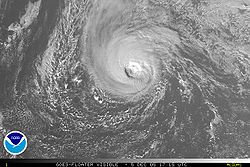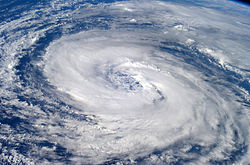Hurricane Epsilon (2005)
Hurricane Epsilon was a Category 1 hurricane that lasted a long time in the central Atlantic Ocean during late November and early December. Epsilon was one of the strongest and longest living hurricanes recorded so late during the year. It was also the twenty-seventh tropical or subtropical storm and fifteenth hurricane of the 2005 Atlantic hurricane season.
| Category 1 hurricane (SSHWS/NWS) | |
 Hurricane Epsilon on December 4, 2005. | |
| Formed | November 29, 2005 |
|---|---|
| Dissipated | December 8, 2005 |
| Highest winds | 1-minute sustained: 85 mph (140 km/h) |
| Lowest pressure | 981 mbar (hPa); 28.97 inHg |
| Fatalities | None reported |
| Damage | None |
| Areas affected | No land areas |
| Part of the 2005 Atlantic hurricane season | |
Epsilon formed from a non-tropical low that steadily became a tropical storm on November 29. The storm became a hurricane on December 2, in a highly unfavorable climate for a regular tropical cyclone. Anyhow, Epsilon managed to stay as a hurricane for a few more days while confusing and frustrating forecasters at the National Hurricane Center before dissipating on December 8.
Storm history
Tropical Storm Epsilon developed out from an extratropical storm in the central Atlantic Ocean on November 29 that had slowly gained tropical characteristics similar to Tropical Storm Delta.[1] It was far east from Bermuda at the time and never would get close to land. Epsilon steadily strengthened into a strong tropical storm before it weakened a little bit on December 1. The official forecasts from the National Hurricane Center predicted Epsilon would weaken further in the highly unfavoritable environment before becoming an extratropical system again.[2] Unexpectedly, Tropical Storm Epsilon strengthened again on December 2 and became a hurricane over cooler waters about 21–24 °C (70–75 °F) with continuing wind shear; which are the conditions that are highly unfavorable for a regular tropical cyclone. The official forecasts continued to predict weakening and dissipation but Epsilon did not follow the forecaster's predictions, and remained at hurricane strength for several more days. At one point on December 4 it was thought that Epsilon had weakened into a tropical storm for a short time, but later post-analysis showed that Epsilon had never weakened at all. Hurricane Epsilon then strengthened further to its peak intensity of 85 mph (135 km/h) just several hours later.[1]
Hurricane Epsilon frustrated many forecasters back in NHC, and the because Epsilon continued to deny any weakening made NOAA hurricane forecaster Dr. Lixion Avila to say "There are no clear reasons — and I am not going to make one up — to explain the recent strengthening of Epsilon…".[3] This means "I don't know why the storm has gained strength, and I am not going to make up a reason". The storm kept its hurricane strength for five days while most of the six-hourly forecasts during that period called for it to weaken below that hurricane strength.[4] Dr. Avila also claimed that Epsilon had developed a structure similar to one of an annular hurricane, which somehow helped it to keep its strength even though poor conditions still existed.[5]
On December 7, wind shear began to cause Hurricane Epsilon to weaken. The storm lost strength, and it became a tropical storm on the next day. It continued weakening into a tropical depression on December 8, and it dissipated soon after that.[1]
Impact and records
Because Hurricane Epsilon stayed far out at sea and never came near land, no warnings or watches were sent out by the National Hurricane Center. No ships in the ocean reported high winds from Epsilon. Also, the storm caused no damage or deaths.[1]
When Tropical Storm Epsilon formed on November 29, it was the first known time that the 27th tropical or subtropical storm had formed in the Atlantic Ocean during one hurricane season. Hurricane Epsilon was only the 6th ever Atlantic hurricane in December. Epsilon spent more time as a hurricane during December than any other Atlantic storm. This broke the old record held by Hurricane Lili in 1984.[1]
Hurricane Epsilon (2005) Media
Hurricane Epsilon viewed from the International Space Station on December 3
Related pages
References
- ↑ 1.0 1.1 1.2 1.3 1.4 National Hurricane Center. "Tropical Cyclone Report: Hurricane Epsilon" (PDF). NOAA. Retrieved 2006-05-03.
- ↑ National Hurricane Center. "Discussion for Tropical Storm Epsilon, 4:00 p.m. EST, December 1 2005". NOAA. Retrieved 2006-05-03.
- ↑ National Hurricane Center. "Discussion for Hurricane Epsilon, 10:00 a.m. EST, December 4 2005". NOAA. Retrieved 2006-05-03.
- ↑ Gary Padgett. "Summary for Hurricane Epsilon". Tropical Cyclone Database. Archived from the original on 2007-09-29. Retrieved 2006-09-29.
- ↑ National Hurricane Center. "Discussion for Hurricane Epsilon, 4:00 p.m. EST, December 5 2005". NOAA. Retrieved 2006-05-03.
Other websites
|
Tropical cyclones of the 2005 Atlantic hurricane season | |||||||||||||||||||||||||||||||||||||||||||||||
|
|
| ||||||||||||||||||||||||||||||||||||||||||||||
|
| |||||||||||||||||||||||||||||||||||||||||||||||


